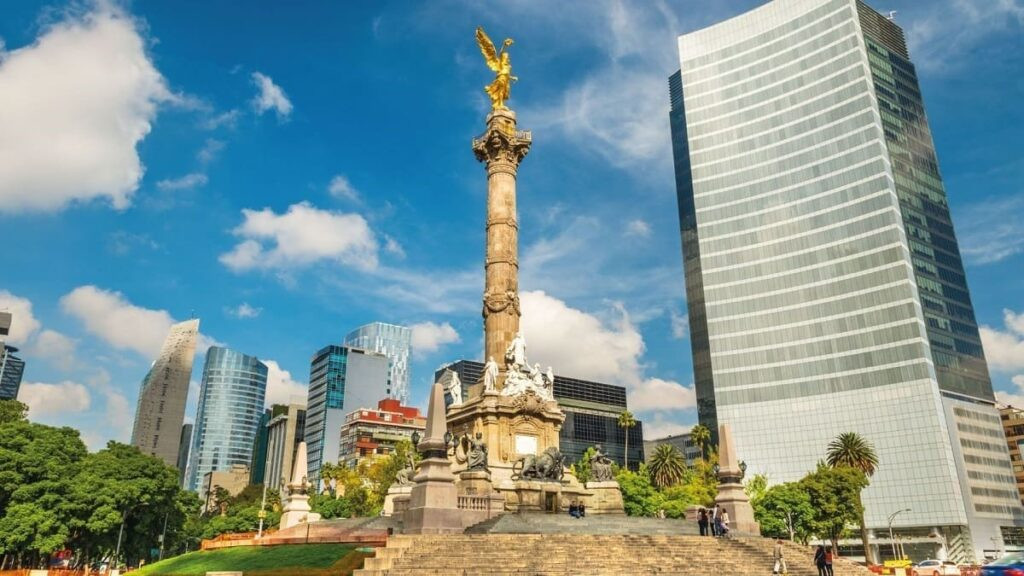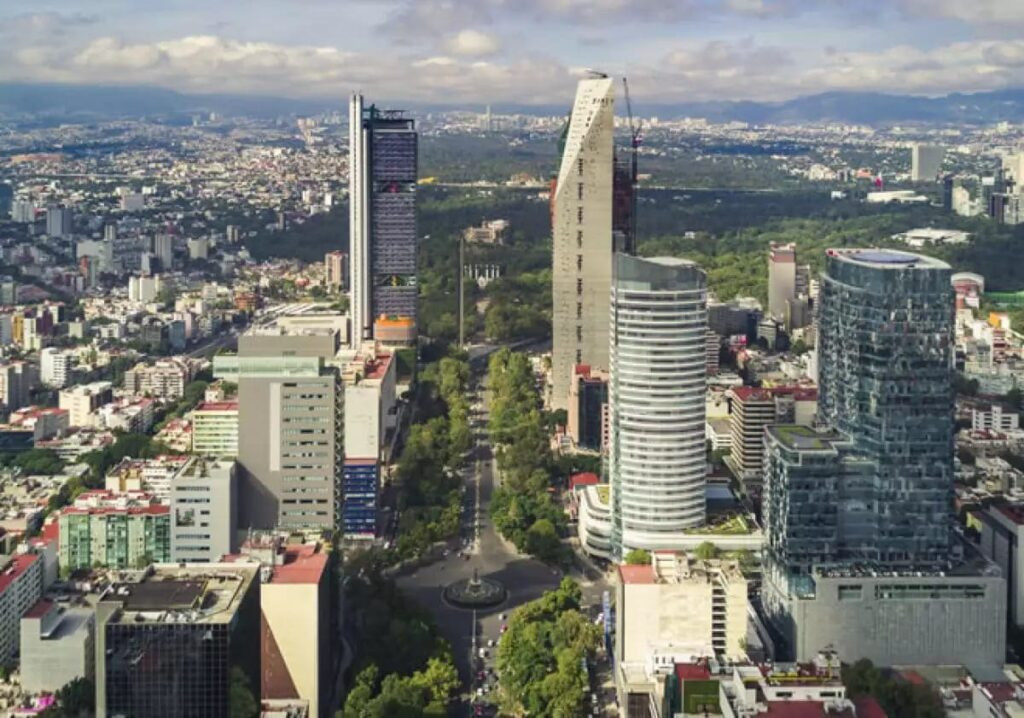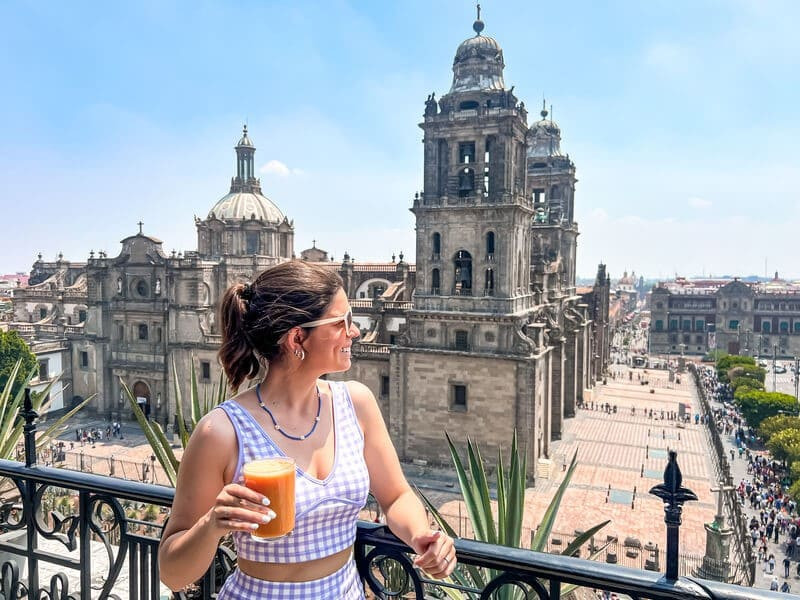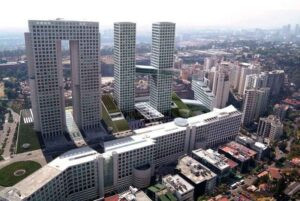Are you planning a trip to Mexico City and curious about its elevation? Understanding the altitude of Mexico City is crucial for a comfortable and enjoyable visit, especially for LGBTQ+ travelers interested in exploring Mexico’s vibrant culture. On gaymexico.net, we provide essential information and resources to help you navigate the city’s high altitude with ease. Let’s explore the unique geographical aspects of Mexico City, offering tips and advice for LGBTQ+ visitors seeking an unforgettable experience in this captivating destination.
1. Unveiling Mexico City’s High Altitude
Mexico City’s altitude is one of its most defining geographical features, situated in the Valley of Mexico, over 7,000 feet above sea level. Surrounded by mountains, this vibrant capital presents unique characteristics every visitor should be aware of.
- Elevation: Approximately 7,350 feet (2,240 meters) above sea level.
- Location: Valley of Mexico, a basin surrounded by the Trans-Mexican Volcanic Belt.
- Significance: Mexico City is among the highest major cities globally, influencing climate, air density, and physical performance for both residents and tourists.
 Mexico City Altitude
Mexico City Altitude
2. What is the Average Elevation of Mexico City?
The average elevation of Mexico City is approximately 7,350 feet (2,240 meters) above sea level, positioning it among the highest major cities worldwide. This high altitude contributes to Mexico City’s unique climate, lower oxygen levels, and distinct physical challenges for visitors unaccustomed to such elevations.
| City | Country | Elevation in Feet | Elevation in Meters |
|---|---|---|---|
| La Paz | Bolivia | 11,942 | 3,640 |
| Quito | Ecuador | 9,350 | 2,850 |
| Bogota | Colombia | 8,661 | 2,640 |
| Mexico City | Mexico | 7,350 | 2,240 |
| Denver | USA | 5,280 | 1,609 |
| Guatemala City | Guatemala | 4,921 | 1,500 |
3. What is the Highest Point in Mexico City?
The highest point within Mexico City is the peak of the Ajusco volcano, reaching an impressive 12,894 feet (3,930 meters) above sea level. Ajusco is located in the Cumbres del Ajusco National Park, southwest of the city center.
- Height: 12,894 feet (3,930 meters)
- Location: Cumbres del Ajusco National Park, southwest of Mexico City
- Attraction: Popular for hiking, offering panoramic views of the city and surrounding landscape.
4. What is the Lowest Elevation Point in Mexico City?
The lowest elevation in Mexico City is located in the central-western areas, with an altitude of approximately 7,316 feet (2,230 meters) above sea level. This area’s lower altitude is due to its historical proximity to the ancient lakebed that once covered much of the Valley of Mexico.
- Elevation: Around 7,316 feet (2,230 meters)
- Location: Central-western parts of the city.
- Reason: Proximity to the former lakebed of the Valley of Mexico.
5. How Does Mexico City’s Altitude Affect Visitors?
Mexico City’s high altitude can significantly affect visitors who are not accustomed to it, primarily due to the lower oxygen levels. Understanding these effects is particularly important for LGBTQ+ travelers planning their itinerary.
- Lower Oxygen Levels: The air is thinner, leading to reduced oxygen intake.
- Common Effects:
- Shortness of breath, especially during physical activities.
- Fatigue and increased tiredness.
- Headaches due to blood vessel dilation in the brain.
- Difficulty sleeping as oxygen levels decrease during sleep.
- Dizziness, nausea, and in severe cases, altitude sickness.
 Altitude Effects
Altitude Effects
6. What are Essential Tips for Travelers to Acclimatize to Mexico City’s Altitude?
To minimize the effects of altitude, consider these tips tailored for travelers, including LGBTQ+ visitors eager to explore Mexico City:
- Hydrate Well: Drink plenty of water before, during, and after your trip to help your blood carry more oxygen.
- Avoid Alcohol and Caffeine: These can cause dehydration, so opt for fruit juices, tea, or soups.
- Moderate Physical Activity: Avoid strenuous activities during your first few days.
- Don’t Smoke: Smoking hinders oxygen absorption.
- Eat Antioxidant-Rich Foods: Consume fruits and vegetables to help your body adapt.
- Sleep with Head Elevated: This can improve breathing during sleep.
- Wear Comfortable Clothing: Dress in layers to stay warm without overheating.
- Acclimatize Gradually: Allow your body time to adjust to the altitude before engaging in intense activities.
 Altitude Recommendations
Altitude Recommendations
7. What Activities are Recommended Based on Altitude Levels in Mexico City?
Plan your activities based on altitude zones for a comfortable experience, especially if you’re an LGBTQ+ traveler eager to explore various parts of the city:
- Low Altitude Zones (up to 7,546 feet or 2,300 meters): Ideal for walking tours in the Historic Center, visiting museums, and exploring markets.
- Mid Altitude Zones (7,546 to 8,858 feet or 2,300 to 2,700 meters): Suitable for moderate hiking and park visits, but avoid running or brisk walking.
- High Altitude Zones (above 8,858 feet or 2,700 meters): Perfect for short hikes, sightseeing tours, and panoramic views. Avoid intense physical exertion.
- Very High Altitude Points (over 9,842 feet or 3,000 meters): Limit activities to cable car rides or vehicle transport to enjoy the views without strenuous walking.
8. How Does Altitude Vary Across Mexico City’s Boroughs?
Mexico City is divided into boroughs (alcaldías), each with varying altitudes, influenced by their location relative to the Valley of Mexico’s topography. The western and southern boroughs generally have higher elevations, while the eastern and northern ones are lower.
| Borough | Altitude (Meters) | Altitude (Feet) |
|---|---|---|
| Cuajimalpa de Morelos | 2,623 | 8,605 |
| Álvaro Obregón | 2,373 | 7,785 |
| Tlalpan | 2,294 | 7,526 |
| Coyoacán | 2,256 | 7,401 |
| Benito Juárez | 2,242 | 7,355 |
| Cuauhtémoc | 2,240 | 7,349 |
 Mexico City Municipalities Altitude
Mexico City Municipalities Altitude
9. What are the Effects of Altitude on Physical Performance?
The reduced oxygen levels at Mexico City’s altitude can affect physical performance, particularly for those not acclimatized. Here’s how:
- Reduced Aerobic Capacity: Lower oxygen saturation reduces the body’s ability to perform sustained physical activities.
- Increased Heart Rate: The heart works harder to compensate for less oxygen, leading to a higher heart rate during exercise.
- Slower Recovery: The body takes longer to recover after physical exertion due to reduced oxygen supply to muscles.
- Early Fatigue: Muscles tire more quickly, decreasing endurance and overall performance.
10. How to Stay Safe and Healthy at High Altitudes in Mexico City?
To ensure a safe and healthy visit to Mexico City, especially for LGBTQ+ travelers planning outdoor activities, follow these guidelines:
- Consult Your Doctor: Before traveling, consult your healthcare provider, particularly if you have pre-existing health conditions.
- Monitor Symptoms: Be vigilant for signs of altitude sickness, such as headache, nausea, dizziness, and shortness of breath.
- Avoid Overexertion: Pace yourself and avoid strenuous activities during the first few days.
- Stay Hydrated: Drink plenty of water to help your body adjust to the altitude.
- Eat Light Meals: Consume easily digestible foods to avoid putting extra stress on your body.
- Limit Alcohol and Caffeine: These can exacerbate dehydration and altitude sickness symptoms.
- Consider Medications: If recommended by your doctor, consider taking medications like acetazolamide to prevent altitude sickness.
- Descend if Necessary: If symptoms worsen, descend to a lower altitude immediately.
11. What is Altitude Sickness, and How is it Treated?
Altitude sickness, also known as acute mountain sickness (AMS), occurs when your body struggles to adjust to lower oxygen levels at high altitudes.
- Symptoms: Headache, nausea, fatigue, dizziness, loss of appetite, and difficulty sleeping.
- Treatment:
- Mild Cases: Rest, hydration, and over-the-counter pain relievers.
- Moderate Cases: Acetazolamide (Diamox) to help your body acclimatize.
- Severe Cases: Immediate descent to a lower altitude, supplemental oxygen, and possibly hospitalization.
It is crucial to be aware of these potential health concerns, especially when planning activities at higher elevations in and around Mexico City.
12. What is the Air Quality Like in Mexico City Due to its Altitude?
Mexico City’s high altitude affects its air quality in several ways:
- Thinner Air: The air is less dense, so pollutants are more concentrated.
- UV Radiation: Higher altitude means less atmospheric protection, leading to increased exposure to ultraviolet (UV) radiation.
- Temperature Inversions: The surrounding mountains trap pollutants, creating temperature inversions that worsen air quality.
- Vehicle Emissions: Heavy traffic contributes significantly to air pollution.
To stay safe:
- Monitor Air Quality: Check daily air quality reports.
- Limit Outdoor Activities: Reduce outdoor exertion on high pollution days.
- Wear Sunscreen: Protect your skin from increased UV radiation.
13. What is the Impact of Altitude on Cooking in Mexico City?
Altitude affects cooking by lowering the boiling point of water:
- Lower Boiling Point: Water boils at a lower temperature at higher altitudes, which can increase cooking times.
- Baking: Baked goods may rise more quickly but can also dry out faster.
- Pressure Cookers: Use pressure cookers to compensate for lower boiling points and reduce cooking times.
- Adjust Recipes: Modify recipes to account for faster evaporation and longer cooking times.
14. How Does Altitude Affect Athletic Performance in Mexico City?
For athletes or those engaging in intense physical activity, Mexico City’s altitude presents unique challenges:
- Reduced Oxygen Uptake: Lower oxygen levels mean muscles receive less oxygen, reducing endurance and power.
- Increased Heart Rate: The heart works harder to deliver oxygen, leading to higher heart rates.
- Acclimatization: Allow several weeks for your body to adapt to the altitude, gradually increasing training intensity.
- Hydration and Nutrition: Maintain optimal hydration and nutrition to support oxygen transport and energy production.
15. Is Flying Into Mexico City Safe for LGBTQ+ Travelers with Pre-Existing Health Conditions?
Flying into Mexico City can be safe for LGBTQ+ travelers with pre-existing health conditions, but careful planning and precautions are essential:
- Consult Your Doctor: Discuss your travel plans and potential risks with your healthcare provider.
- Medications: Ensure you have an adequate supply of medications and any necessary prescriptions.
- Travel Insurance: Purchase comprehensive travel insurance that covers medical emergencies.
- Acclimatization: Allow time to acclimatize upon arrival, avoiding strenuous activities.
- Monitor Symptoms: Watch for any worsening of your pre-existing conditions and seek medical attention if needed.
16. What is the Best Time of Year to Visit Mexico City Considering the Altitude?
The best time to visit Mexico City, considering its altitude, is during the dry season from March to May:
- Dry Season: Less rainfall, clear skies, and comfortable temperatures.
- Temperature: Average temperatures range from the high 60s to low 80s Fahrenheit (15-27 degrees Celsius).
- Air Quality: Generally better air quality due to fewer temperature inversions.
- Fewer Crowds: Fewer tourists compared to peak seasons.
17. How Does Mexico City’s Altitude Compare to Other High-Altitude Cities Popular Among LGBTQ+ Travelers?
Mexico City’s altitude is comparable to other high-altitude cities popular among LGBTQ+ travelers.
| City | Country | Altitude (Feet) | Altitude (Meters) | LGBTQ+ Popularity |
|---|---|---|---|---|
| Mexico City | Mexico | 7,350 | 2,240 | High |
| Bogotá | Colombia | 8,661 | 2,640 | Medium |
| Quito | Ecuador | 9,350 | 2,850 | Medium |
| Cusco | Peru | 11,152 | 3,399 | Medium |
| Santa Fe | USA | 7,199 | 2,194 | Low |
18. Where Can LGBTQ+ Travelers Find Resources and Support in Mexico City?
LGBTQ+ travelers can find a variety of resources and support in Mexico City:
- Local LGBTQ+ Organizations: Contact local organizations for information and assistance.
- LGBTQ+ Friendly Accommodations: Stay in LGBTQ+ friendly hotels and guesthouses.
- Community Centers: Visit community centers for social events and support networks.
- Online Forums: Join online forums to connect with local LGBTQ+ communities.
- Gaymexico.net: Visit our website for comprehensive guides, tips, and community resources.
19. How Does the Altitude Impact Local Cuisine in Mexico City?
Mexico City’s altitude impacts the local cuisine by affecting cooking times and ingredient preparation:
- Slower Cooking Times: Lower boiling points require longer cooking times for certain dishes.
- Ingredient Adaptation: Chefs adapt recipes to accommodate changes in texture and flavor.
- Traditional Cooking Methods: Techniques like pressure cooking are commonly used to reduce cooking times.
- Unique Flavors: Certain ingredients may develop unique flavors due to the specific conditions at high altitudes.
20. How Can LGBTQ+ Travelers Make the Most of Their Visit to Mexico City Despite the Altitude?
LGBTQ+ travelers can make the most of their visit to Mexico City by planning strategically:
- Prioritize Acclimatization: Allow time to adjust to the altitude before engaging in strenuous activities.
- Pace Yourself: Avoid overexertion and plan for rest days.
- Stay Hydrated: Drink plenty of water throughout the day.
- Explore at Lower Elevations: Start with activities in the city center and gradually venture to higher areas.
- Consult Local Guides: Seek advice from local guides familiar with altitude-related challenges.
- Connect with the Community: Engage with local LGBTQ+ communities for support and recommendations.
- Utilize Gaymexico.net: Visit our website for tailored resources and travel tips.
Understanding Mexico City’s high altitude and taking appropriate precautions will ensure a safe, enjoyable, and memorable experience for all LGBTQ+ travelers.
FAQ about Mexico City Altitude
1. Why is Mexico City so high in altitude?
Mexico City is located in the Valley of Mexico, a high basin surrounded by mountains. This geographical feature contributes to its high altitude.
2. Is it hard to breathe in Mexico City?
Some visitors may experience shortness of breath due to lower oxygen levels. Acclimatization and hydration can help mitigate this.
3. How do I avoid altitude sickness in Mexico City?
Stay hydrated, avoid alcohol and strenuous activities, and acclimatize gradually to avoid altitude sickness.
4. What is the elevation of the Mexico City airport?
The Mexico City International Airport (AICM) is located at an elevation of approximately 7,316 feet (2,230 meters).
5. How long does it take to adjust to the altitude in Mexico City?
It typically takes a few days to a week to adjust to Mexico City’s altitude.
6. Can altitude affect my sleep in Mexico City?
Yes, lower oxygen levels can disrupt sleep patterns. Sleeping with your head elevated may help.
7. Are there any medications to help with altitude sickness?
Acetazolamide (Diamox) can help prevent altitude sickness. Consult your doctor before use.
8. Does Mexico City’s altitude affect the taste of food?
Altitude can subtly affect the taste and texture of food, influencing cooking methods and recipes.
9. How does the altitude affect my heart rate in Mexico City?
Your heart rate may increase as your body tries to compensate for lower oxygen levels.
10. Is Mexico City’s altitude dangerous for people with heart conditions?
People with heart conditions should consult their doctor before traveling to Mexico City due to the altitude.
Explore Mexico City with Confidence
Understanding Mexico City’s altitude is essential for planning a comfortable and enjoyable trip. For LGBTQ+ travelers seeking reliable information and community resources, visit gaymexico.net. Discover detailed travel guides, tips for navigating the city, and connections to local LGBTQ+ communities. Mexico City is a welcoming and vibrant destination, and with the right preparation, you can experience all it has to offer.
For more information, feel free to contact us:
Address: 3255 Wilshire Blvd, Los Angeles, CA 90010, United States.
Phone: +1 (213) 380-2177.
Website: gaymexico.net.